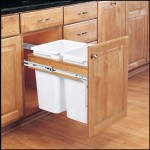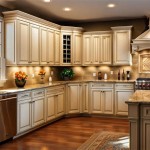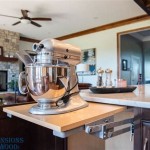What To Use On Kitchen Cabinets To Clean: A Comprehensive Guide
Maintaining clean kitchen cabinets is essential for both hygiene and aesthetics. Grease, food splatters, and dust accumulate over time, marring the appearance of the cabinets and potentially harboring bacteria. Selecting the appropriate cleaning agents and methods is crucial to effectively remove dirt and grime without damaging the cabinet finish. This article provides a detailed overview of various cleaning solutions, their applications, and essential techniques for keeping kitchen cabinets spotless.
Understanding Kitchen Cabinet Materials and Finishes
Before embarking on any cleaning endeavor, it is paramount to identify the type of material and finish used on the kitchen cabinets. Common cabinet materials include wood (oak, maple, cherry, pine), laminate, melamine, and metal. Finishes can range from paint and stain to clear coats, veneers, and thermofoil. Each material and finish reacts differently to various cleaning agents. Using an inappropriate cleaner can lead to discoloration, scratches, peeling, or other forms of irreversible damage.
Wood cabinets, for example, are porous and susceptible to water damage. Excessive moisture can cause warping, swelling, or cracking. Laminate and melamine cabinets, on the other hand, are generally more resistant to water and chemicals but can be scratched by abrasive cleaners. Metal cabinets, often used in commercial kitchens or modern designs, may be prone to rust or corrosion if not properly cleaned and protected.
Therefore, the cleaning approach must be tailored to the specific cabinet characteristics. Consult manufacturer recommendations or test a small, inconspicuous area before applying any cleaning agent to the entire surface.
Effective Cleaning Solutions for Kitchen Cabinets
A variety of cleaning solutions are available, each with its own strengths and weaknesses. The choice depends on the type of soil (grease, food stains, dust) and the cabinet material. The following are among the most commonly used and effective options:
Dish Soap and Water: This is a gentle yet effective all-purpose cleaner suitable for most cabinet types. A diluted solution of mild dish soap in warm water can remove light grease, dust, and everyday grime. Ensure the soap is thoroughly rinsed off to prevent residue buildup.
Baking Soda Paste: Baking soda is a mild abrasive that can help remove stubborn stains and dried-on food particles. Mix baking soda with a small amount of water to create a paste. Apply the paste to the affected area, gently scrub with a soft cloth or sponge, and rinse thoroughly. This method is particularly useful for removing stuck-on grime around knobs and handles.
Vinegar and Water Solution: Vinegar is a natural degreaser and disinfectant. A 50/50 solution of white vinegar and water can effectively cut through grease and remove odors. Spray the solution onto the cabinets, let it sit for a few minutes, and then wipe it clean with a damp cloth. Vinegar should be used with caution on certain finishes, as its acidity can potentially damage them.
Commercial Cabinet Cleaners: Numerous commercial cabinet cleaners are specifically formulated for various cabinet materials and finishes. These products often contain a blend of detergents, solvents, and protectants designed to clean effectively without causing damage. Always follow the manufacturer's instructions carefully and test the product on an inconspicuous area before applying it to the entire cabinet surface.
Degreasers: For heavily soiled cabinets, particularly in areas near the stove or oven, a dedicated degreaser may be necessary. Degreasers contain stronger solvents designed to dissolve grease and oil. Use degreasers sparingly and with proper ventilation, as they can be harsh and potentially harmful. Always wear gloves and eye protection when handling degreasers.
Wood Cleaners and Polishes: For wood cabinets, specialized wood cleaners and polishes can help maintain their natural beauty and protect the finish. These products often contain oils and waxes that nourish the wood and create a protective barrier against moisture and scratches. Follow the manufacturer's instructions carefully, and avoid using excessive amounts of polish, which can lead to a dull, waxy buildup.
Step-by-Step Cleaning Techniques for Kitchen Cabinets
Regardless of the chosen cleaning solution, following a systematic approach is crucial for achieving optimal results and preventing damage to the cabinets. The following steps outline a general cleaning procedure:
Preparation: Begin by clearing the countertops and removing any items from the cabinets that might obstruct the cleaning process. Cover the countertops and floor with drop cloths or towels to protect them from spills and splashes.
Dusting: Use a soft brush, microfiber cloth, or vacuum cleaner with a brush attachment to remove loose dust and debris from the cabinet surfaces, including the doors, drawers, and frames. Pay particular attention to crevices, corners, and decorative moldings.
Cleaning: Apply the chosen cleaning solution to a soft cloth or sponge, ensuring it is damp but not soaking wet. Gently wipe down the cabinet surfaces, following the grain of the wood if applicable. Avoid excessive pressure, which can damage the finish.
Rinsing: After cleaning, rinse the cabinets with a clean, damp cloth to remove any soap residue. Ensure all traces of the cleaning solution are removed to prevent streaking or buildup.
Drying: Use a clean, dry cloth to thoroughly dry the cabinets. This is particularly important for wood cabinets, as standing water can cause damage. Drying also helps prevent water spots and streaking.
Polishing (Optional): For wood cabinets, applying a wood polish after cleaning can help restore their shine and protect the finish. Follow the manufacturer's instructions carefully and avoid using excessive amounts of polish.
Hardware Cleaning: Clean cabinet hardware, such as knobs and pulls, separately using a suitable cleaner. Metal hardware can often be cleaned with a mild detergent and water, while ornate or antique hardware may require more specialized cleaning methods. Ensure the hardware is completely dry before reattaching it to the cabinets.
Stubborn Stains and Grime: For stubborn stains or areas with heavy grease buildup, repeat the cleaning process or use a stronger cleaning solution. Baking soda paste or a dedicated degreaser can be effective for tackling these challenging areas. Always test the cleaning solution on an inconspicuous area first to ensure it does not damage the finish.
Periodic Deep Cleaning: In addition to regular cleaning, consider performing a deep cleaning of the kitchen cabinets every few months. This involves removing all items from the cabinets, cleaning the interior surfaces, and thoroughly cleaning the exterior surfaces. A deep cleaning can help prevent the buildup of dirt and grime and keep the cabinets looking their best.
Preventative Measures: Maintaining clean kitchen cabinets is an ongoing process. To prevent future grime buildup, wipe up spills immediately, regularly dust the cabinets, and use a range hood when cooking to minimize grease accumulation. Applying a protective sealant or wax to the cabinets can also help repel dirt and moisture.
By understanding the materials and finishes of the kitchen cabinets, selecting appropriate cleaning solutions, and following proper cleaning techniques, individuals can maintain the beauty and longevity of their cabinetry. Regular cleaning and preventative measures are key to achieving a spotless and hygienic kitchen environment.

How To Clean Kitchen Cabinets Dianella Polishing

Kitchen Cabinets Cleaning The Do S And Don Ts

How To Clean Grimy Kitchen Cabinets With 2 Ingredients

How To Clean Your Kitchen Cabinets

How To Clean Kitchen Cabinets 3 Best Bad Cleaners For Abbotts At Home

How To Clean Wood Kitchen Cabinets Shelfgenie

Kitchen Cabinet Steam Cleaner Magic Machine Cleanify

How To Clean Kitchen Cupboards 1 Maid Service House Cleaning

3 Super Easy Ways To Clean White Kitchen Cabinets And Avoid

A Basic Guide For Keeping Your Kitchen Cabinets Clean Edgewood Cabinetry








